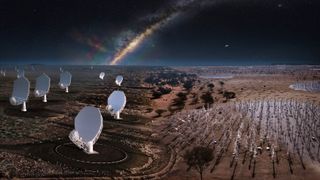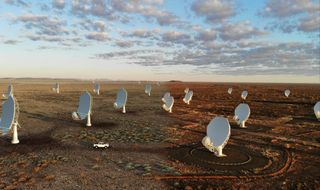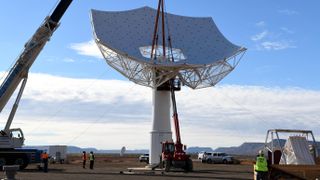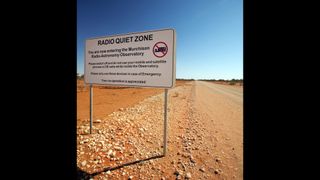The mission to reduce the carbon footprint of astronomy
"We are doing science at an industrial scale. That's why we have a large carbon footprint."

When Adriaan Schutte took up his job as a chief power engineer at the Square Kilometre Array Observatory (SKAO), he had a clear goal in mind: to build the world's most sustainable research facility.
It was an ambitious goal. SKAO is set to become the world's largest radio telescope, an astronomical observatory that uses tens of thousands of antennas to catch radio waves coming from distant stars, planets and galaxies.
Astronomy is power-hungry and radio astronomy is its most insatiable discipline. To power its two sprawling arrays in the Australian and South African wilderness, but also the computers that will digest the hundreds of gigabytes of data the antennas will gather every second, SKAO, once complete, will require 12 megawatts of electrical power (about as much as 10,000 average U.S. households).
Construction work at the observatory's two sites officially started last year, but the telescopes will only come online in the second half of this decade. With a designed lifetime of 50 years, SKAO will be probing the universe at least into the 2070s, a time when climate concerns are likely to be much more pressing than today.
"Radio astronomy is like particle physics," Schutte told Space.com. "We are doing science at an industrial scale. We are just so technologically advanced today that you need a massive facility if you want to discover anything new ... that's why we have a large carbon footprint."
Schutte, originally from South Africa, started his career in the mining industries of his homeland. There, he witnessed both environmental destruction and leadership's old-school resistance to change. "I had vowed never to return to that again," he said.
Related: Epic radio images give most-detailed views of distant galaxies
Get the Space.com Newsletter
Breaking space news, the latest updates on rocket launches, skywatching events and more!
He joined SKAO in 2014, the year the project finally moved into design, after more than two decades of planning. The next year, at the United Nations Climate Change Conference in Paris, nations signed the Paris Agreement, committing to limit the global temperature rise to 2.7 degrees Fahrenheit (1.5 degrees Celsius) compared to pre-industrial times.
Astronomers, as Schutte discovered, were early proponents of environmental responsibility, and getting SKAO management on board with his vision was easy.
"When they originally set up the project, they were very worried about the amount of power being consumed and the cost of that power," Schutte said. "So it was a really good time to join and bring the sustainability focus with me from the beginning."

Surviving in a carbon neutral world
Radio astronomy might be power hungry among sciences. But Schutte admits that compared to the industries he started in, it is responsible for only a small drop in the ocean of greenhouse gas emissions that need to be tackled for the world to avoid the worst climate change scenarios.
"Some of the plants I used to work at in my early career use about 100 times as much power as SKAO," he said. But that, Schutte added, doesn't let science off the hook. In a world threatened by a climate collapse, its future may depend on its ability to clean up its act.
"We are entering an era where carbon emissions will be capped," said Schutte. "There will be a carbon budget for the whole planet and the various industries will compete for that. And in a situation where we only have so much carbon that we can emit and we have to choose between manufacturing goods that people need to survive and doing basic science, I think it's obvious what we are going to do."

Five times worse than mere mortals
For Adam Stevens, a postdoctoral research fellow in astrophysics at the University of Western Australia, taking climate action is not just a point of survival for the carbon-hungry science, but also a point of honor for the scientists doing this science.
"I think there's an important aspect of leadership here," Stevens told Space.com. "Scientists and physical scientists in particular understand the physics of climate change and the importance of it. Many of us spend a lot of time trying to convince others to take it seriously. But what we should really be doing is leading by example and showing that we're able to do the things that are important to our industry and our jobs in a way that's environmentally sustainable."
Stevens was one of the first astronomers to take a deeper look at the carbon footprint of his profession. A couple of years ago, the idea came up during lunch discussions with his peers at the university. As representatives of the younger, more environmentally conscious generation, the postdocs were curious whether any data on astronomy's carbon footprint existed. He asked at a staff meeting.
"Everyone was like, 'Yeah, that's a good question,'" he said. "But when they looked around, they found that they really didn't know the answer."
It fell to Stevens to find out how much climate-warming carbon Australian astronomers produce. The paper that came out of this quest was published in Nature Astronomy in September 2020 and has since inspired other self-reflecting studies by astronomers all over the world. For Stevens, who specializes in modelling the evolution of galaxies, the findings were eye-opening.
The paper found that per year, an Australian astronomer produced on average 40.7 tons (37 metric tonnes) of carbon dioxide equivalent (a measure used to compare emissions from various greenhouse gases on the basis of their global-warming potential). That's about 40% more than the carbon footprint of an average Australian adult and five times as much as an average resident of Earth. Out of that, 24 tons (22 tonnes) on average stemmed from the astronomer's use of supercomputers.
"I thought, going in, that flying was going to be the worst thing," Stevens said. "I had an inkling of how carbon intensive that was. What I didn't realise was how energy intensive supercomputing and running observatories was. Supercomputing in particular accounted for something like 60% of our carbon footprint."

Power-hungry computers
Astronomy's need for supercomputing, just as that of other scientific disciplines, is only bound to grow. In his paper, Stevens estimates that the demand for supercomputing of Australian astronomers will increase from 400 million central processing unit (CPU) core-hours in 2020 to 500 million by 2025.
At SKAO, super-computing will be responsible for 50% of the overall electricity consumption, split equally between two data centers in Australia and South Africa. The other 50% will be consumed directly by the telescopes.
When Schutte first joined SKAO, the observatory's estimated power consumption was close to 25 megawatts, more than double the current requirement. The team achieved the reduction by choosing the most efficient technologies every step of the way. For example, by replacing graphics processing units (GPU) in the computers that pre-process raw data generated by the antennas with more energy efficient devices called Field Programmable Gate Arrays, they cut the energy needed by a "significant amount".

Greening up
Experts, however, caution that in computing, any improvement in efficiency is quickly lost in the increasing demand, a trend that cannot be expected to slow down.
Reducing the carbon footprint of all data-driven sciences will therefore require switching to renewable sources of electricity.
A study by researchers from the Max Planck Institute for Astronomy in Germany published shortly after the one by Stevens found that German astronomers have a much lower carbon footprint than their Australian counterparts. The difference is largely down to the much higher proportion of renewable power in Germany's energy mix compared to staunchly coal-reliant Australia, Knud Jahnke, the lead author of the study, told Space.com.
As a result, a German astronomer would produce on average 20 tons (18.1 tonnes) of carbon dioxide equivalent per year, less than a half of the carbon footprint of the Australian astronomer. Still, this value means a German astronomer produces 60% more carbon than an average German citizen.
Unlike Australian astronomers, whose greenhouse gas emissions mostly come from the electricity used to power computing centers and observatories, the Germans' biggest contribution comes from air travel.
In pre-COVID times, the carbon footprint of shuttling to and from conferences and other meetings would add up to 9.35 tons (8.5 tonnes) of carbon dioxide equivalent per astronomer per year, nearly a half of their overall annual emissions. Still, they beat out Australian astronomers, who release 13.2 tons (12 tonnes) per year of carbon equivalent in air travel. However that remains less than half of their electricity-related carbon emissions.
But Jahnke believes that Germany's astronomers can't waste their time resting on their environmental laurels. "As astronomers, we have a much higher dependency on carbon emissions than many other sciences," Jahnke told Space.com. "How will we do science 15 years from now, or in the year 2050? It's pretty clear that we cannot have this level of carbon emissions in the year 2030 or 2040."
Off grid
With the SKAO, Schutte can't tap into Germany's acceptance of clean energy; he must develop his climate plans with half of the observatory's equipment in coal-reliant Australia. The remote locations of the arrays, while challenging, are turning into an advantage.
The Australian array, to be built 500 miles (800 kilometers) away from Perth, Australia's westernmost city, will comprise over 130,000 Christmas tree-like dipole antennas arranged in spiral arms spreading from a dense core. It will sprawl across hundreds of square miles of land owned by Australian aboriginal communities.
The South African array, in the Karoo desert, will consist of nearly 200 parabolic dishes, each 50 feet (15 meters) wide, arranged in a similar spiral-like pattern.
The remoteness of those locations is key to the success of an observatory targeting radio emissions, which human technology also relies on. Both areas are protected by their respective governments as radio-quiet zones where the use of electronic and telecommunication devices is strictly limited. That means no cell phones, no terrestrial TV, no radio coverage.
"These telescopes are incredibly sensitive," Schutte said. "We will be essentially able to pick up a mobile telephone more or less anywhere in the solar system."
Just as the world's buzzing telecommunication networks don't reach the SKAO sites, neither do local electricity grids. The observatory will need to produce most of its own power; how it solves this problem will determine its carbon footprint.
"Both of the telescopes are essentially in desert areas, so we have incredible solar resources there," Schutte said. "Solar power, especially in sunny areas, is the lowest-cost energy, so we would be stupid if we didn't use that."
Still, the solution is not straightforward. The observatory will need power every minute of every day. Though Schutte might dream of carbon neutrality, given current technology, a fully sustainable solution would be, if not impossible, then extremely costly, requiring large amounts of lithium-based battery storage, which by itself presents a major environmental problem.
"Our modelling shows that if we build a hybrid power station with today's technology, combining photovoltaics, some battery and some diesel generators, then up to 45% renewables is completely feasible and is, in fact, the lowest-cost option," Schutte said. "So 45% of renewables is our bare minimum, but we also see in our modelling that we can go up to 90%. Anything above that would not be feasible at the moment."
Retrofitting
SKAO, however, is a brand new facility that can build reduced emissions in from the beginning. But what about existing observatories? Those designed and built in an age where climate was an afterthought if anything?
The European Southern Observatory (ESO) operates several telescopes at three sites in the Atacama Desert in Chile, including the Very Large Telescope. Just like SKAO, ESO is considering Earth as well as the stars. In 2019, the organization ordered an audit of its carbon footprint that thoroughly assessed every aspect of its activities.
The audit found that ESO's annual carbon footprint was 30.8 kilotons (28 kilotonnes) of carbon dioxide equivalent with the biggest contributors being energy usage by the observatories (40%), the emissions generated during production of purchased items (30%) and business travel (10%).
If calculated per annual budget, ESO's operations are about as carbon intensive as those of the internet and telecommunication industries, ESO astronomer Robin Arsenault, who is in charge of the observatory's emissions reductions program, told Space.com. The observatory's carbon footprint [scaled by budget] is about a 10th that of car manufacturing and about a fifth of the retail industry, the audit found.
But since then, ESO has embarked on a major greening program that might see the observatory's emissions slashed by more than 4.4 kilotons (4 kilotonnes) in the next couple of years.
In the past, ESO's remote mountain-top observatories met most of their power needs using private turbines running on liquified petroleum gas. "It's a little better than diesel, but it still has a huge carbon footprint," Arsenault said.
In 2016, ESO built its first photovoltaic solar power plant at the La Silla Observatory on the Paranal mountain. On sunny days (of which there are plenty in Atacama), the 1.7-megawatt plant produces even more energy than the observatory needs, Arsenault said.
Last year, ESO announced construction of a 9-megawatt photovoltaic plant that will feed the upcoming Extremely Large Telescope and existing telescopes on Paranal.
"It will cover the full electricity demand of the telescopes during daytime," Arsenault said.
The future of astronomy
ESO's supercomputers reside at the organization's headquarters in Garching, Germany, and computer experts are already looking at ways to reduce their power consumption. ESO staff in the future may be getting new laptops less often to reduce the carbon footprint related to the production of purchased equipment. In many cases, astronomers from all over the world who want to use ESO's powerful telescopes will have to let go of a major perk of their profession — the privilege to travel to far-away locations, such as the Atacama Desert.
"In the long term, we want to do more remote operations so that astronomers do not travel to Chile all the time," Claudia Burger, the director of administration at ESO told Space.com. "We conduct already 80% of the observations this way, with our local staff doing the observations instead of the astronomers coming from all over the world."
Other world-class observatories, including the Vera Rubin Observatory that the U.S. is currently building in Chile, plan a similar approach relying on remote observing.
Out of the astronomers Space.com spoke to, everyone was in favor of a less jet-setting and less carbon intensive future of astronomy. Astronomers are prepared to do things differently, through virtual platforms rather than constant travel, citing the COVID-19 pandemic as a game-changer that showed them that it was indeed possible.
"We have been stuck in this classical model of conferencing since 100 years ago when, if you wanted people to talk and listen to each other and get inspired, you had to move them physically and bring them to the same location," said Jahnke, the German astronomer studying the profession's carbon footprint. "But that's not only expensive and time consuming, it's also inefficient. You can stuff a full week of meetings and talks, but honestly, most people are saturated by day two anyway."
As for Schutte at SKAO, his job doesn't end when diggers cut into the radio-quiet deserts of Australia and South Africa. Technology will keep advancing as fast as it has done in the past decades and with it further improvements will become achievable.
"With these observatories, you refresh some of your technology every five years or so," Schutte said. "So every five years, you have the opportunity to bring in more energy efficiency. I hope that 10 years from now, we will see significant improvements not only in computer technology, but also in energy storage, which is the limit that we have now."
Follow Tereza Pultarova on Twitter @TerezaPultarova. Follow us on Twitter @Spacedotcom and on Facebook.
Join our Space Forums to keep talking space on the latest missions, night sky and more! And if you have a news tip, correction or comment, let us know at: community@space.com.

Tereza is a London-based science and technology journalist, aspiring fiction writer and amateur gymnast. Originally from Prague, the Czech Republic, she spent the first seven years of her career working as a reporter, script-writer and presenter for various TV programmes of the Czech Public Service Television. She later took a career break to pursue further education and added a Master's in Science from the International Space University, France, to her Bachelor's in Journalism and Master's in Cultural Anthropology from Prague's Charles University. She worked as a reporter at the Engineering and Technology magazine, freelanced for a range of publications including Live Science, Space.com, Professional Engineering, Via Satellite and Space News and served as a maternity cover science editor at the European Space Agency.
